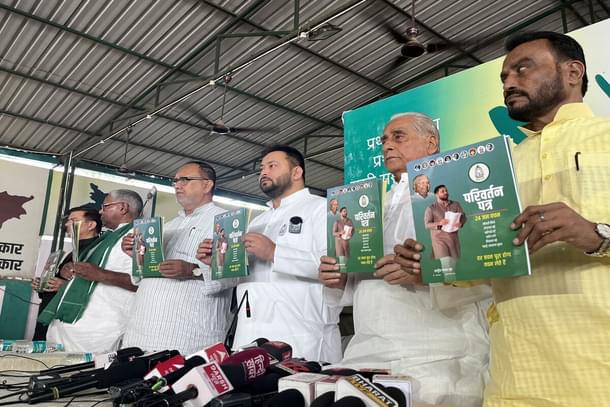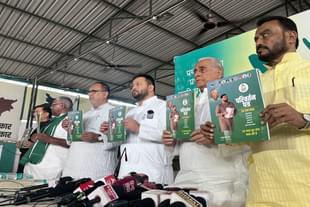Bihar
Of Government Jobs: How Bihar’s ‘Sarkari Naukri’ Obsession Shapes Its People And Politics
Abhishek Kumar
Oct 24, 2025, 12:10 PM | Updated 12:18 PM IST
Save & read from anywhere!
Bookmark stories for easy access on any device or the Swarajya app.


In the film Manjhi: The Mountain Man, Dashrath Manjhi is met with an unexpected development. His wife's Gauna (the traditional departure of a female child bride to her in-laws' home upon reaching adulthood) has been halted.
His wife's father has found a prospective groom who is a watchman in Gaya's municipality. Manjhi's family belongs to the Mahadalit community, illustrating that even amongst Bihar's most marginalised populations, government employment reigns supreme.
Non-feasible promise
Tejashwi Yadav, the de facto leader of the Rashtriya Janata Dal (RJD), understands this obsession and seeks to leverage it in the upcoming 2025 state assembly elections.
In a press conference announcing his vision for Bihar's chapter of the Indian National Democratic Inclusive (INDI) alliance, Yadav made an extraordinary promise of giving government jobs to every family.
"My first announcement after the election notification is that whichever Bihar family has no government job, we will bring a new law to ensure one. They [the NDA] have not given any jobs, but once we form the government, we will enact a new law within 20 days and ensure that all such families get a government job within 20 months of our government's formation," said Yadav.
Yadav is only the second politician in India to make such an ambitious promise. Before him, Sikkim's Pawan Chamling, facing three decades of anti-incumbency, made a similar pledge. He even distributed appointment letters, creating a bureaucratic nightmare for his successor, Prem Singh Tamang.
While Chamling's promise received limited scrutiny from civil society and media, Tejashwi faces far greater accountability.
Political rivals from the National Democratic Alliance immediately termed the promise impractical, and economists echoed these concerns.
Bihar has approximately 2.8 crore families, of which at least 2.5 crore would qualify for government jobs under this scheme. The state currently employs no more than 20 lakh government workers, meaning the creation of at least 2.5 crore new positions would be necessary.
Even using conservative estimates of ₹20,000 average monthly salary (the actual figure exceeds ₹35,000), the minimum annual cost would be ₹6 lakh crore for a state whose annual budget recently crossed ₹3 lakh crore for the first time in history.
It defies logic that Yadav would be unaware of such elementary mathematics. Yet he chose to make the promise anyway, seeking the advantage that comes with setting the narrative.
Yadav understands that rebuttals will have less reach than the original appeal, which by the following morning had reached poor households across Bihar, whilst counters came primarily through English newspaper articles and party spokesperson statements.
However, the deeper factors driving these statements are rooted in the social, economic, and political evolution of the state and how this journey has shaped the psychological makeup of Bihar's 13 crore-strong population.
The Babu Complex: Status, Power and Hierarchy
In Bihar's government offices, villagers address bureaucrats as "Babu", a term rooted in both paternity and seniority. A significant section uses it to address politicians or individuals they respect.
For instance, the longest-serving cabinet minister, Jagjivan Ram, is often called Babu Jagjivan Ram, signifying his mobility from a less respected to a more respected position in society.
When applied to bureaucrats, the term indicates not merely respect, but also positions the citizen lower in a dominance hierarchy where government servants are perceived as modern-day feudal lords.
Somewhere between respect and feudality lies the rationale for government job obsession, even at a time when the world is moving towards problem-solving-oriented industries.
Conversations with older individuals reveal that government jobs were not always the preferred career path for everyone. A former Inspector General of the state had to be pulled from the comfort of Jawaharlal Nehru University by his landlord father to join the Indian Police Service.
Bureaucrats like Raj Kumar Singh, the late Acharya Kishor Kunal, former DGP Abhayanand, and Gupteshwar Pandey treated their positions as one vocation amongst many.
Singh later entered politics, Abhayanand taught physics during and after his IPS career, whilst Pandey and Acharya Kishor Kunal became prominent faces of Sanatan dharma in the state.
Numerous individuals declined government services to manage their farmlands and expansive havelis. This trend shifted when the zamindari system was administratively abolished, and retaining power became synonymous with commanding the topmost layers of bureaucracy.
For less affluent sections, particularly Scheduled Castes and Scheduled Tribes, government jobs initially offered relief from farm labour and passage to more peaceful, dignified existence within their communities.
Manjhi belonged to the SC community, explaining why his father-in-law sought alliance with a government job holder's family.
The Mandal Revolution and the Race for Dominance
For Other Backward Classes (OBCs), comprising well over 60 per cent of Bihar's population, the community experienced significant intra-class inequalities.
Wealthy families like those of B.P. Mandal or Pappu Yadav had numerous advancement opportunities, whilst poorer families worked on others' lands with minimal possibility of upward mobility due to inadequate education.
This is where the Mandal Commission and OBC reservation emerged, mandating a fixed percentage of government jobs for OBCs.
At the introduction, upper castes viewed government jobs as a means to ensure hierarchy, whilst SCs and STs saw them as economically relieving opportunities providing upward mobility.
When OBCs began securing substantial portions of these positions, they experienced both upward mobility and opportunities to establish dominance.
The race for domination intensified alongside identity politics. Being called "Babu" represented the caste hierarchy's continuation in government offices for upper castes.
Conversely, new entrants from backward castes, especially OBCs, began viewing this salutation as newly gained power, further leading to distinctions between Bada (senior) Babu and Chhota (junior) Babu, fitting neatly into office hierarchies.
This parallels Black West Indian cricketers playing their sport in a cold, stoic, bloodthirsty manner against White teams. In a geopolitical order established by White colonisers, defeating them at their own "gentleman's game" with brute force (pace bowling, a trait they were narratively confined to by Whites) signified satisfying cultural victory.
Crowds supported West Indians not merely for victory, but for providing rare vindication to souls subjugated by centuries of emotional manipulation and moral relativism.
To a lesser extent, this phenomenon appears in caste mobility and its interaction with Bihar's socio-economic public sphere.
Despite countless accounts of OBC or SC individuals distancing themselves from their communities after securing government jobs, people still celebrate them because their success provides inspiration.
Liberalisation Without Liberation
This period coincided with early economic liberalisation (LPG reforms), suggesting the state should have gradually ceded power to individuals and private entrepreneurs, with government job obsession peaking before the new millennium.
It remained a distant dream due to politicisation of caste and socialism.
Outside the government jobs ecosystem, this phenomenon often translated into support for revenge mentality where villages were massacred in the name of reversing caste superiority.
Average people from backward communities were taught that their support for heinous acts would translate into direct power.
This forced an unprecedented industrial exodus, ironically making land and labour cheaper. By the time Jungle Raj (during which barely 30 per cent of police posts were filled) ended in Bihar, per capita income stood at ₹7,914, with the industrious population migrating out of state.
For those remaining, government jobs remained the only fixed monthly or yearly income source, despite delayed salaries.
Government recruitment's rarity made these positions even more valuable in a state where Bajaj's faulty scooters remained status symbols even after one and a half decades of economic liberalisation in the neighbourhood.
The Nitish Kumar Era: Progress Without Paradigm Shift
During Nitish Kumar's tenure, the scooter disappeared, but not government job obsession, despite his privatisation push during the first eight years as chief minister.
Kumar inherited cheap land and labour, which he utilised by imprisoning strongmen and assuring investors of protection from extortion.
Bihar transformed, but not its people's collective residual mentality. For instance, when he announced over three lakh teacher vacancies (most temporary contract positions) applicants flooded the system despite knowing poor rural road connectivity would create hellish experiences.
"When my father joined, he did so expecting that one day, these teachers would become permanent with salaries of well over ₹30-40,000. Even if he was being paid ₹5,000 back then, it did not hurt," said Saurav, a Gurgaon-based medical professional who migrated out of Bihar after college.
When asked why his father accepted such conditions, he responded: "Look, no one was forced to do the job. There was no due diligence, and hence my father could choose to go or not go. There was no K.K. Pathak system or punching system back then. Out of ₹5,000, just pay 10-20 per cent for attendance fixing and the rest is just extra income. Who cares? It was only an add-on."
Saurav's father continued managing his farms whilst enrolled as a teacher.
Simultaneously, Kumar's law and order emphasis led to increased police personnel, opening new waves of respect for a force that had lost its sheen due to state neglect in the previous decade.
As Kumar gained more popularity, the craze for recruitment under his administration gained more traction.
"People used to boast that Nitish Kumar has signed their joining letter" said Sushil Shahi, a private teacher.
The Private Sector Problem
To put it simply, in pre-2005 Bihar, the state's abandonment of its citizens meant that to attain some sort of security, aligning with the government became a necessary tool for survival.
During Nitish's early years, the state earned so much goodwill that the perception of power and control lay with it, and hence the craze for government jobs only intensified.
These dynamics are explained by how the private sector compensated employees during Kumar's tenure. Bihar's private sector salaries barely exceeded minimum wages.
However, Kumar shouldn't shoulder the entire blame. He first had to cleanse the system of entrenched extortionists, create investment-conducive environments, offer incentives, and simplify permissions. Only then could private capital flow.
Even arriving investments required stabilisation time, therefore couldn't afford higher wages. The state lacked significant capital inflow, and even Kumar acknowledged new investments were mostly local, explaining why high growth rates owed more to low base effects and public investment.
This is why Kumar sought special category status, which would transform private investment sentiments. "Bihar's growth is primarily driven by public investment, and until we have private investment inflows, it will be difficult to sustain our growth rate after the next five years," Kumar stated after a 2012 Bihar Industrial Investment Advisory Council meeting comprising corporate chiefs.
The trickle-down effect of such bottlenecks has a negative impact on the psyche of the average young person.
For someone working in private pharmaceutical companies offering less than ₹10,000 for 12-13 hour workdays, their neighbour earning ₹5,000-6,000 from the state government for minimal work sounds more attractive.
This classic dilemma explains sustained government job obsession even during Kumar's early tenure: Bihar's version of the rat race.
Watching government-employed neighbours enjoy comfort, security, and reasonable pay with minimal work inspired others to pursue the same path, creating cycles where each generation prepares itself, or its children, to join that world where security trumps productivity.
Political Instability and Lost Momentum
When Kumar was demanding special category status, he had momentum and opportunity to break this vicious cycle. However, his failure to anticipate Indian politics' future trajectory proved disastrous for private investment sentiments in the state.
Kumar switched sides, joining hands with RJD, largely seen as architects of anti-development, caste-based politics in Bihar. Haphazard implementation of populist alcohol bans further dampened prospects.
These developments forced investors to reconsider priorities, as every violent incident (whether traced to RJD or not) created déjà vu patterns.
Kumar again switched sides, rejoining BJP over criminalisation of political issues. Later he did another round of the monkey balancing.
However, after 2014, the state has never seen a stable government that can assure investors of positive outcomes, except for brief periods when leaders like Syed Shahnawaz Hussain took control of the industry ministry. By definition, such moments were short-lived.
With time, the formation of new industrial capital entered uncertain territory, with factories not generating desired output.
What began as a thin stream of industrial activity under Kumar soon turned into a cash-rich scheme for political and bureaucratic elites, with the fruits of growth being cordoned off from private entrepreneurs.
The Manufacturing Paradox And Hurdles
A 2024 NITI Aayog report titled Macro and Fiscal Landscape of the State of Bihar reveals that between 2013-14 and 2022-23, Bihar's manufacturing sector grew at 17.4 per cent, triple the national average of 5.5 per cent.
Yet revenue from factories did not translate into profits. The state's gross value added (GVA) formed only 11.2 per cent of gross value output (GVO), the lowest in India.
Two factors (bureaucratic leakages and political patronage, with subsets including land acquisition challenges, a labyrinthine permit system, and extortion masked as official facilitation) explain the stagnation of the last decade.
Land is the sorest nerve of this iron triangle. Bihar's latest credible land survey dates back over 100 years, and many revenue records still lie with the former offices of the Bengal Presidency.
Fragmented holdings, outdated records, poor awareness, and reliance on oral transfers have given rise to disputes that drag on for decades. One dispute was famously settled after 108 years.
Land disputes are rampant in Bihar, with more than 3,000 cases filed every year and over 1,000 murders annually linked directly to these conflicts.
An astonishing 60 per cent of the state's criminal cases stem from unresolved or contested land ownership. Seventy to 80 per cent of murder cases are traced back to land-related conflicts.
Modern solutions like comprehensive land surveys only complicate the problem due to discrepancies between official landholders and possessors who acquired land through oral transfers.
Permit system has improved with a corresponding rise in hidden costs
Until recently, the state's Byzantine clearance system was a relic of socialism joining hands with feudalism to kill the industrial spirit.
In the Department for Promotion of Industry and Internal Trade's (DPIIT) Business Reforms Action Plan (BRAP) 2020 rankings, Bihar was ranked 26th out of 36 states.
By 2022, it was reclassified as an "Emerging Business Ecosystem," lumped with small Union Territories like Andaman and Nicobar.
However, sentiments have improved recently, with Adani's Peerpainti power plant headlining new initiatives.
The state has approved the acquisition of thousands of acres for new industrial parks, secured central approval for a 1,670-acre integrated manufacturing cluster in Gaya, introduced a land return policy for stalled units, and rolled out incentive structures with SGST refunds of up to 300 per cent through the Bihar Industrial Investment Promotion Package (BIPPP-2025).
These moves signal that Bihar may be emerging from its legacy of inertia towards a more investor-friendly industrial environment.
Progress does not come without the hurdle of unsolicited extortion. After the introduction of Direct Benefit Transfer (DBT), pilferage was reduced to a large extent. However, the vacuum was promptly filled by cash rackets targeting industry.
In March 2024, the Enforcement Directorate seized ₹11.64 crore in cash from senior bureaucrats, including IAS officer Sanjeev Hans, implicated in a construction tender kickback scandal.
This is not a one-off incident. It is a commonly accepted fact that officers and politicians close to Chief Minister Nitish Kumar have amassed massive wealth, both in cash and land.
Senior journalist Kanhaiya Bhellari reported that a person once in charge of Kumar's security is now worth more than ₹200 crore.
Ashok Chaudhary, a senior minister considered part of Kumar's inner circle, was accused by Prashant Kishor of suspicious land allotments worth hundreds of crores. Reportedly, after Kumar was informed, he barred Chaudhary from entering his office.
The top-down model creates incentives for those lower in the pecking order to engage in corruption.
In August 2025, three officials were arrested in separate bribery cases across Bihar: Sub-Inspector Mashroor Alam in East Champaran was caught on video taking cash from a motorist; Sub-Inspector Umesh Ram in Aurangabad was trapped accepting ₹20,000 for a favourable report; and Revenue Clerk Satyendra Singh in Khagaria was nabbed taking ₹20,000 for land mutation.
Speaking on condition of anonymity, a businessman accused Motor Vehicle Inspectors of seizing his 17 trucks, which led to the shutdown of his business. Today, he is forced to work as a hotel manager.
Another businessman from Muzaffarpur had a similar scare when he was demanded ₹50,000 by MVIs.
Political connections helped him "settle" it for ₹2,000, but the details he uncovered were infuriating and draconian. The officer told him they were given a target of extorting ₹75 lakhs across six districts, come what may.
The rackets fuel patronage networks in which people like a paan shop owner or a printout shop owner pay lakhs to get permission for opening shops near block offices. The return on investment comes from their proximity to officers, not from actual sales.
Three categories of Biharis
A common thread binds all these problems: proximity to government.
Who are the ministers and politicians earning crores? Government organs. Who are the bureaucrats working in tandem with them? Government servants. Who are the small shop owners keeping accounts for these high-level corruptionists? Those benefiting from top-level corruption. Who are the big industries generating any profitability? Conglomerates with deep pockets to get their work done.
The state that was supposed to exemplify equality has ironically devised systems where power is the main ingredient in generating financially profitable resources, thanks to harbingers of socialist politicians and national-level parties providing political support and resources.
Under these circumstances, Biharis divide into three categories.
The first category comprises those who compromise self-respect and become local politicians, brokers, or shop owners to gain system entry and amass properties.
They represent the visible arm of Bihar's informal power economy, acting as middlemen between people and state with firm grips over licences, tenders, postings, and subsidies.
They thrive not through innovation or productivity but through utility to those above them. Their political loyalty is their capital. These are grassroots godfathers, whose patronage replaces process and whose shadows extend across entire blocks, districts, regions, and sometimes the state.
The second category comprises the academically and manually bright who migrate from the state for private sector jobs, hoping their talents will be utilised.
They represent Bihar's tragic irony: earning by exporting labour and intellect to less bureaucratic states.
Back home, their remittances sustain the local economy, ensuring their system escape becomes a tool keeping it alive. Those building Maharashtra's, Delhi's, or Gujarat's industries end up financing their homeland's subsistence at the hands of elites.
The third category comprises the academically bright but financially poor who prepare for government jobs to attain social relevance.
Their lives are suspended between modernity and nostalgia. In the streets of Bhikhana Pahadi, Mussallahpur Haat, Old Rajinder Nagar, reels of BPSC toppers and films where heroes become collectors, not creators, rule imaginations.
This is a system where self-worth's moral compass shifts to clearing exams rather than solving problems. When met with failure, the system doesn't collapse; their faith in merit does, and they either succumb to low-profile jobs or become more informed system brokers.
Leap of faith required to break the vicious cycle
For much of its post-independence existence, Bihar has witnessed economic agency's reduction to a function of government proximity.
It has largely been a system prizing compliance over curiosity, status over substance, and stability over risk. Bihar's private sector doesn't just struggle with red tape; it competes with cultural legitimacy of government employment.
The question is: how will it exit this vicious circle?
Perfection is a myth leading Biharis to their second-best option of replication. When Bihar entered the final phase of its dark era, it was clubbed with states like Uttar Pradesh and Madhya Pradesh facing similar situations.
Both states successfully navigated that realm through patchy government reforms finally paving the way for sustained political stability: MP under Shivraj Singh Chouhan and UP under Yogi Adityanath.
Big money comes hoping for long-term survival, which only people-centric governments can ensure.
The question here is twofold: Can Biharis do it? The state's collective consciousness has repeatedly shown willingness to do so. Last time they placed trust in Nitish Kumar, which he tossed for political idealism in 2013.
So the larger question is whether the political class coming to power can deliver or not.
The argument of breaking free of government shackles ends on government's will, which exemplifies how omnipotent the government has become. Biharis are forced to seek growth through the same apparatus that prevents it.
BJP leaders have consistently highlighted that the NDA government has given the state a solid launchpad. The onus now falls on whoever takes charge of it.
Decades-long psychological buildup won't subside until one generation feels that its family plates depend on eligible earning members' abilities, not state patronage.
The obsession with government jobs is merely a subset of attempts to appear unfazed by uninvited vagaries in a state where one generation isn't certain about the sufficiency of wealth it accumulates for the next generation.
Dashrath Manjhi broke a mountain to reach civilisation. Bihar's hardest mountain, however, is the one built from its own faith in the government's omnipotence.
Abhishek is Staff Writer at Swarajya.





